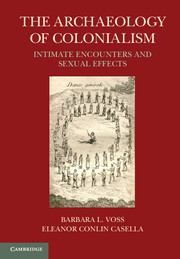Book contents
- Frontmatter
- Contents
- List of Illustrations
- List of Tables
- List of Contributors
- One Intimate Encounters
- Two Sexual Effects
- Section I Pleasures and Prohibitions
- Section II Engaged Bodies
- Section III Commemorations
- Section IV Showing and Telling
- Sixteen Sexualizing Space
- Seventeen Showing, Telling, Looking
- Eighteen Obstinate Things
- Conclusion
- Index
- References
Seventeen - Showing, Telling, Looking
Intimate Encounters in the Making of South African Archaeology
from Section IV - Showing and Telling
Published online by Cambridge University Press: 05 June 2012
- Frontmatter
- Contents
- List of Illustrations
- List of Tables
- List of Contributors
- One Intimate Encounters
- Two Sexual Effects
- Section I Pleasures and Prohibitions
- Section II Engaged Bodies
- Section III Commemorations
- Section IV Showing and Telling
- Sixteen Sexualizing Space
- Seventeen Showing, Telling, Looking
- Eighteen Obstinate Things
- Conclusion
- Index
- References
Summary
Intimate Encounters
The kind of intimacy that interests me here is not intimacy between persons in the past nor between people and objects (although both have their place in the story that follows), but rather the intimacy that arises in the relation between an archaeologist and her or his materials. That is, I am interested in intimacy in the act of knowledge construction. The conception that I have of the site and the moment of knowledge construction is that these are inherently intimate, also ambiguous, unstable, subject to risk and overdetermination. It becomes the job of the disciplinary discourse to normalize and contain this process, to draw off the element of risk and playfulness. It is the job of an analysis like this one to restage the drama and intimacy of these encounters, as a way of understanding better the nature of the discourse and the forms of knowledge that do and do not arise from it. Intimacy, overdetermination, disavowal: such is the tight knot of telling and not telling, showing and not showing, which exists at the heart of each archaeological encounter.
I focus on two historical encounters. Both involve the South African archaeologist John Goodwin (1900–1959) and indigenous people of the Cape (Figure 17.1). What these encounters have in common, besides their approximately coeval nature (both date to the decade of the 1930s) and the fact that they belong to the same general part of the world, is that both are made available to us through sets of photographs in the archive. They also both involve encounters between the person of the archaeologist and sets of bodies framed as objects – black bodies – one group living, the other dead. In the overdetermined contexts of colonialist archaeology, I use these encounters to frame an enquiry into the place of imagination and desire in the making of archaeological knowledge. In the second place, I am interested in forms of public exhibition and display, in the idea of an archaeological gaze, and in a local history of looking. In the third place, I am interested in exploring the resonances that arise among the archive, the photographic artefact, and the body in the grave. Centrally, I am interested in forms of archaeological and scientific practice and the limits of discourse and in the forms of subtle and overt violence that shadow them and that create their counterparts, the categories of the unspeakable, the unshowable, and the unthinkable.
- Type
- Chapter
- Information
- The Archaeology of ColonialismIntimate Encounters and Sexual Effects, pp. 290 - 302Publisher: Cambridge University PressPrint publication year: 2011



